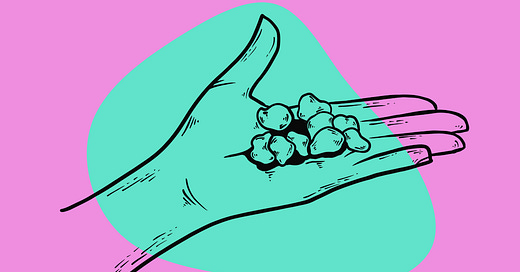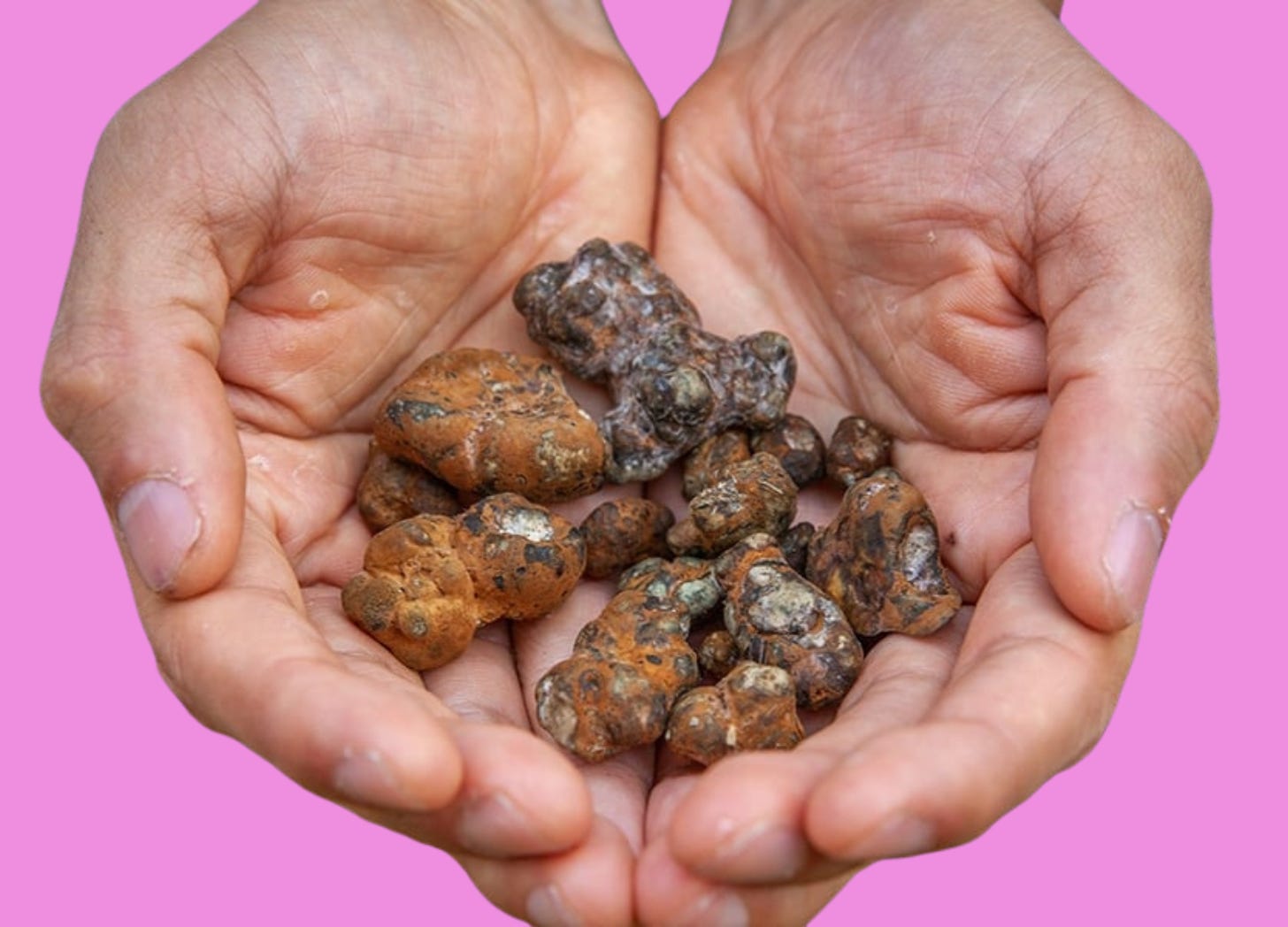The Story of P. tampanensis: Psychedelia, Murder, & the Evolution of Magic Truffles
Steven Pollock discovered a unique species of mushroom in 1977 that form dense masses of psychedelic mycelium (called sclerotia). Today, they're more commonly known as "Philosopher's Stones."

Psilocybe tampanensis is a peculiar species with underwhelming small, brown mushrooms.
What lay below the surface of these mushrooms is much more impressive. This species produces large masses of sclerotia — dense, truffle-like clumps of mycelium.
These clumps of mycelium contain the psychedelic tryptamines psilocybin and psilocin.
P. tampanensis was one of the first species cultivated for magic truffle production, and it kickstarted the truffle market in the Netherlands — essentially saving the psilocybin scene when magic mushrooms were made illegal in 2008.
Dutch law specifically banned the sale of above-ground “mushrooms” but didn’t ban the mycelium. Because the sclerotia of P. tampenensis grow underground and are made up of mycelia, these were shielded from the new laws.
Magic truffles remain legal in the Netherlands today, and no further moves to restrict the mushrooms have since been taken seriously.
What Are Psychedelic Truffles?
Technically, a truffle refers to a group of ectomycorrhizal fungi (fungi that live inside the roots of plants) in the genus Tuber.
Magic truffles aren’t truffles at all. Instead, they’re densely packed clumps of mycelium called sclerotia. They’re called truffles simply because they look like the thick, lumpy, underground fruiting bodies produced by species such as Tuber melanosporum (Black Truffles) and Tuber magnatum (White Truffles).
Unlike traditional edible truffles, the sclerotia of P. tampanensis serve no purpose in reproduction. Truffle-forming magic mushrooms still rely on the formation of mushrooms above the surface to spread their spores.
So why do magic mushrooms produce sclerotia if not for reproduction?
This dense clump of underground sclerotia is believed to help the mushroom survive hard times like drought or changes in food availability.
Sclerotia can survive underground almost indefinitely. They remain dormant during hard times and reactivate when conditions are just right. This is believed to be a key mechanism for surviving harsh winters and extended droughts in cooler climates. The Psilocybe genus is typically only found in tropical and sub-tropical climates.
Psilocybe tampanensis Still Produce Mushrooms
P. tampanensis mushrooms are small, brown, and unassuming. Even though this species is one of the most commonly cultivated magic mushrooms on Earth, it's rarely given an opportunity to fruit. Cultivators are far more interested in forcing it to grow sclerotia.
Magic truffles are relatively weak in terms of potency. Psilocybin levels rarely exceed 0.7% per dried weight (some much less). This puts them on par with weaker strains of Psilocybe cubensis.
All this means is that users need to consume a few extra grams to reach psychedelic doses. If 3 grams of Psilocybe cubensis does the trick, you’ll need closer to 4 or even 5 grams of psychedelic truffles for the same effect.
The Story of The Philosopher’s Stones
These mushrooms have quite a history — after a fluke discovery by one of the greatest mycologists ever to live, they were almost lost entirely when he was brutally murdered a few years later.
The real rise to fame didn’t come until the Dutch government made a sloppy error trying to ban psychedelic mushrooms. Odd language in the bill they drafted accidentally fuelled a booming truffle market that thrives to this day.
Here’s how the story of the philosopher’s stones rise to fame…
1. The Discovery of Psilocybe tampanensis
Psilocybe tampanensis was discovered in 1977 by none other than Steven Hyaden Pollock — a renowned mycologist who is often credited with the establishment of the famous Penis Envy strain of Psilocybe cubensis.
Pollock found the sample near Tampa, Florida — hence its species epithet “tampanensis.”
While mushroom hunting in a sandy meadow grazed by Braham cattle with close friend and fellow mycologist Gary Lincoff, he stumbled across the mushroom. Although relatively boring in appearance — producing small brown mushrooms — Pollock was instantly intrigued.
He brought the specimen back to his remote Winnebago laboratory where he dissected it and excised a small piece of stem tissue to an agar culture. While driving back from Tampa to his base in San Antonio, Pollock observed mycelial growth on one of the agar plates.
2. An Unexpected Discovery
Some weeks later, in his lab, he noticed something unusual about the Psilocybe tampanensis agar dishes in his lab. The mycelium began to glisten and form small hard granules. What he discovered was a unique treasure that would change the course of his cultivation efforts entirely…
The lumps grew larger and larger until they were the size of doorknobs. The masses of flesh were tinted in shades of blue and purple. Pollock gave in and decided to experiment. He removed, dissected, and photographed the small lumps before boldly stepping into the unknown by eating them.
Pollock noted that the truffle-like growths tasted “nutty and tart” — a combination of kiwi fruit and cashew nuts. He also noted the tell-tale effects of the psychedelic compound psilocybin.
Knowing that what he’d discovered was something special, he called Lincoff to tell him that what they discovered in Tampa was “the Philosopher’s Stone” — and so, the iconic “magic truffle” was born.
Around one year later, in 1978, Steven Pollock and the Mexican mycologist Gastón Guzmán scientifically described the species and classified it as “Psilocybe tampanensis” in the Mycotaxon publication.
3. “Truffles the Size of Ostrich Eggs”
After discovering the Philosopher's Stone, cultivating Psilocybe tampanensis became a priority for Steven Pollock. He wanted to bring these psychedelic truffles to the masses, believing that they could “transport the fortunate consumer to states of spiritual transcendence and jubilation far beyond the realm of ordinary psychedelics.”
From the minute he discovered the Philosopher’s Ston, he began developing a cultivation technique to produce masses of sclerotia. He set up a huge cultivation lab and perfected his technique.
Pollock began producing sclerotia from Psilocybe tampanensis, some that grew to enormous proportions. In a 2011 Harper’s article, Gary Lincoff reported that some of Pollock's Philosopher's Stones grew to “the size of ostrich eggs.”
Pollock planned on selling Psilocybe tampanensis sclerotia via the mail service in the United States. He and his colleague, Michael Forbes, founded the company "Hidden Creek" in 1979 to sell the truffles he produced. Pollock and Forbes advertised their company in the monthly issue of High Times magazine.
Pollock and Forbes successfully sold hundreds of P. tampanensis truffles through Hidden Creek, but the enterprise came to an abrupt end after a devastating turn of events.
4. The Murder of Steven Pollock
In 1981, less than two years after Hidden Creek was founded, Pollock’s work came to a sudden end when he was tragically murdered in his home lab.
The 33-year-old was found dead in a pool of blood with a one-inch laceration on his forehead. His pocket linings were turned inside out, and a series of keys were scattered around his body in a "halo." The house was turned upside down, and a collection of ornamental glass mushrooms was arranged on a chest beside his door.
Apparently, Pollock was found clutching a Penis Envy mushroom in each hand, but the crime report never detailed this. Either way, his murder was peculiar. It was ruled out as an unfortunate burglary, but the person who killed Pollock appeared to be frantically searching for something specific.
Over 1,753 spawn jars were recovered from Pollock’s cultivation lab, many of them containing mycelium of Psilocybe tampanensis. Ten pounds of ground P. tampanensis sclerotia were also recovered. Pollock had prepared them for analysis just days before his murder.
Walter Pollock (Steven's father) warned the police that destroying his son's work would be a grave mistake, believing that the rare species he had discovered could harbor great medical value. Regardless, the DEA destroyed everything related to the illicit mushrooms, and so Pollock's life work and the Philosopher's Stone legacy were brought to an abrupt end.
Walter Pollock contacted his son’s business partner Micheal Forbes and attempted to persuade him to move Hidden Creek to Haiti, where he had criminal connections that could provide protection. However, Forbes declined the offer and dissolved the business.
The magic truffles all but disappeared after this dramatic chain of events, and the rare species wouldn’t be found in the wild again for over a decade.
The murder of Steven Pollock remains unsolved to this day…
5. Magic Truffles Reborn
The survival of the P. tampanensis species can be credited to a man named Stephen L. Peele — the author of a book titled “The Golden Doorknob” (2001).
Stephen Peele was a former police officer from Virginia who used his background in law enforcement to obtain a Schedule 1 permit that allowed him to cultivate and research psilocybin mushrooms.
Peele lays out his 20 years of research into psilocybin mushrooms in The Golden Doorknob. After Pollock’s death, Peele began cultivating P. tampanensis from a spore sample from Pollock’s lab that “survived the wrath of the DEA.”
In his book, Peele talks about the species, saying: “It was once only held by 5 people when I deposited it into the CBS Culture Bank in the Netherlands to ensure that it would not die out. I was once told that even Paul Stamets lost his culture.”
The sample Peele sent to the Netherlands in the mid-90s kickstarted the Dutch magic truffle market. At the time, magic mushrooms were legal to produce, sell, and consume in the liberal European country. Magic truffles were also cultivated and sold during the 1990s, but magic mushrooms were far more popular.
However, in 2008, a decision from the Dutch government to ban psychedelic mushrooms changed everything.
In 2008, psilocybin-producing mushrooms were made illegal in the Netherlands. However, the legality of psilocybin truffles remained unchanged. This caused the truffle market to boom. With vendors unable to sell shrooms legally, cultivators began producing masses of truffles using both Psilocybe tampanensis and another truffle-forming species called Psilocybe mexicana.
Fast forward to the present day, Psilocybe tampanensis truffles can be purchased from local street vendors known as “Smart Shops” in most major cities and towns. They’re sold fresh in vacuum-sealed plastic under the name “Philosopher’s Stones.”
How to Grow Magic Truffles
Outside of Amsterdam, most people opt for growing Psilocybe cubensis (check out our grow guide here) rather than truffles.
In general, P. cubensis is a better option for new growers. They’re somewhat stronger than P. tampanensis and (aside from some contamination headaches) are super easy to cultivate using very low-tech (and cheap) growing equipment.
However, for the psychedelic aficionados, growing P. tampanensis mushrooms can be extremely rewarding. While the effects they produce are nearly identical to other psilocybin mushrooms, many swear they produce a distinct psychedelic effect.
Here’s one of the best resources we’ve come across that lays out the nuances of growing magic truffles at home from one of our favorite YouTube creators — Mycophilia.
Please note this guide is intended for intermediate growers. Some basic knowledge about the process of growing mushrooms is needed. Check out our starter guide to get up to speed.
Further Reading:
The Story of Steven Pollock’s Murder (MEL Magazine)
Help Us Grow 🌱
Tripsitter was built by a community of psychedelic advocates — but it’s people like you that allow us to thrive.







